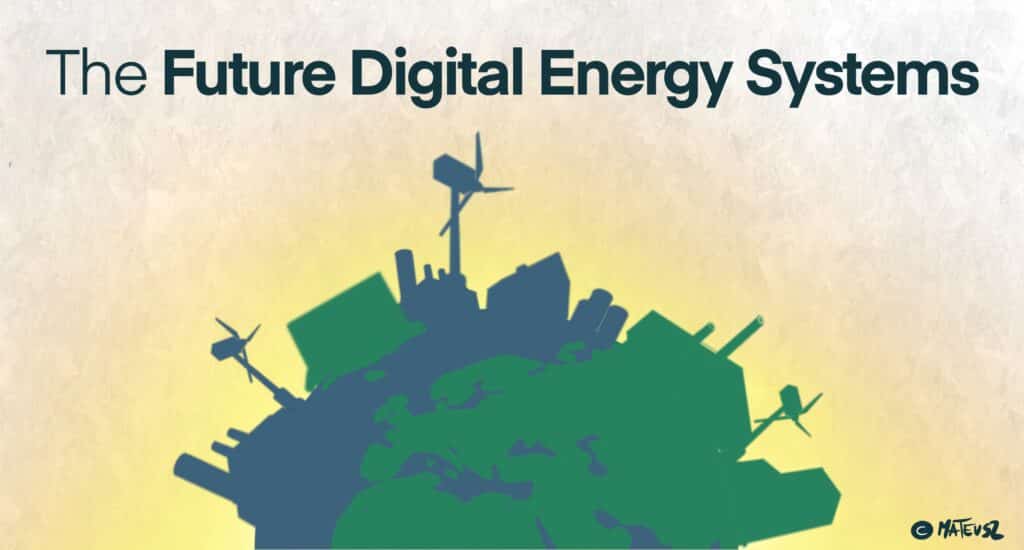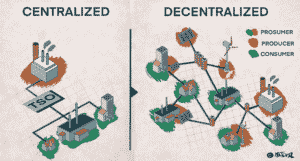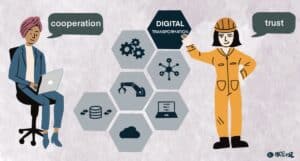Do we, as industry and society, have enough tools and motivation to stop global warming? Let’s see how and what ought to be done if we want to save our planet. Having in mind available and
future technologies, frameworks, legislation, and people, we need to look for new structures of cooperation. For the time being, let’s call these structures — The Future Digital Energy Systems. Probably we will find much better naming in coming years, but for now, it quite precisely describes expectations that were set by two fundamental themes that are on the agendas of the whole industry — Energy Transition and Digital Transformation. Let’s look at those monsters one by one and try to define The Future Digital Energy Systems from the perspective of three simple questions:
- Why do we need The Future Digital Energy Systems?
- What are The Future Digital Energy Systems?
- How they will differ from the actual energy landscape?
Energy Transition
Energy Transition is a worldwide reaction of the industry to needs set by legislation, society, and ultimately major culprit — climate change. In simple words, it is an energy system transformation
from centralized, hydrocarbon generation to decentralized, lower emission generation, transportation, storage, and use (1).
If you look at the picture above, you can find a new market role — prosumer. This is a participant of the energy market who can produce and consume energy. This is the central point of the whole Energy Transition and the main reason why we need The Future Digital Energy Systems. The two-way relationship between producer and consumer is getting blurred, and we need to shift to an open market with appropriate flexibility and security of transactions. All technology, legislation and investments have to be reconfigured toward a much bigger number of participants with less available capacity.
It is not new to our society. We have made such shifts before and proved that it can be successful. Take a look at financial markets and stocks. In the beginning, financial markets were built on the supply/demand principle with strong central regulations (governments). If you wanted to participate in this market you needed to have capital, connection, and appropriate assets. Most of the society was not participants in the financial markets — they were only consumers of the goods. Sounds similar to nowadays’s energy systems, isn’t it?
The situation started to change
With the introduction of a stock exchange, the situation started to change. People have entered financial markets and become stakeholders of companies. Nowadays, every participant is an equal
“prosumer” of the financial market by using products created by companies but also becoming an owner of those companies (if not directly then through different pension or healthcare systems,
subsidies, and donations). Claiming the status quo of existing energy systems (centralized, hydrocarbon-based) needs appropriate reorganization of the whole system. Take a look at a comparison of two systems — centralized (pre-Energy Transition) and decentralized (post-Energy Transition).
Centralized Decentralized
Principle of working Supply/Demand Cooperation
Security Overcapacity and monitoring Flexibility & Storage
Safety Assets quality Volume
Responsibility Central Group
Energy Transition is a major driver for The Future Digital Energy Systems, but it will not be possible to reach the end goal without our second monster. To make a step change from centralized to
decentralized systems, we need to embrace Digital Transformation.
Digital Transformation
Have you noticed that I am using a plural form for The Future Digital Energy Systems? I do not believe we will have one global system which will rule the whole energy market. It will be, again,
similar to financial markets — legislation will push towards worldwide unification (to have a common framework) but an adaptation of the requirement will be on the country, municipal, or
even household level. Nevertheless, all those systems need to be integrated and interoperable with each other (to maintain the principle of working — cooperation).
Without Digital Transformation, it will be extremely difficult to maintain a certain level of trust and cooperation. Thanks to the adoption of digital technology, companies can improve their business process, increase intimacy with customers and suppliers and faster adapt to changing environments.
Putting trust and cooperation at the forefront of guiding principles for Digital Transformation we can equip ourselves with technologies and mechanisms which will promote secure and open
communication (i.e., blockchain technology), fair and equal treatment of the participants (common platforms) and faster development (inter-and intra- industry collaborations).
Blockchain – a leading technology that can support
- A significantly big volume of active energy markets participants will require robust, efficient, and open communication to maintain an appropriate level of integrity and speed of the whole system. A leading technology that can support this is blockchain (2).
- New energy systems, like none of the technology before, need to base on Dumas’s maxim “all for one, one for all”. All participants need to have equal access to assets and technology,
and the entrance barrier needs to be as low as possible. This is addressed by a concept called System of Systems (3). - By scaling up digital transformation to vast companies and society, the time to market of new technologies is decreasing (like hydrogen, small modular reactors, solar geoengineering,
etc.) which eventually will start a chain reaction of the golden era for Future Digital Energy Systems.
As a result, Digital Transformation is a major enabler for The Future Digital Energy Systems, and without appropriate guidance and care for this part, it will be extremely difficult to adapt to Energy Transition.
Conclusion
In the end, there is one more ingredient related to The Future Digital Energy Systems, which was not properly addressed. It is by far the most important, and it is the main reason why I started
writing this series of articles.

saving our planet to all of us. We need to be aware and start making a change in how we produce, consume, and think about energy.
With The Future Digital Energy Systems articles series, I’d like to address the main drivers and enablers of our future energy landscape. Analyzing available technology, and required changes in
the organizations, legislation, and society, I want to disenchant and simplify all actions needed to fulfil net-zero commitments and limit global warming.
Thank you again for taking the time to read this article. If you enjoyed this post please click LIKE, to share it with your network click SHARE, and if you have any more thoughts drop them in
COMMENTS.
References:
1. KBC (A Yokogawa Company) – Industrial Energy Transition Manifesto (Whitepaper) –
https://www.kbc.global/insights/whitepapers/industrial-energy-transition-manifesto/
2. Wei Hu, Huanhao Li (2021). A blockchain-based secure transaction model for distributed
energy in Industrial Internet of Things. Alexandria Engineering Journal. Pages 491-500.
https://doi.org/10.1016/j.aej.2020.09.021*
3. Mark F. Ruth, Benjamin Kroposki (2014). Energy Systems Integration: An Evolving Energy
Paradigm. The Electricity Journal. Pages 36-47. https://doi.org/10.1016/j.tej.2014.06.001
KBC presents the latest solutions for energy efficiency management






